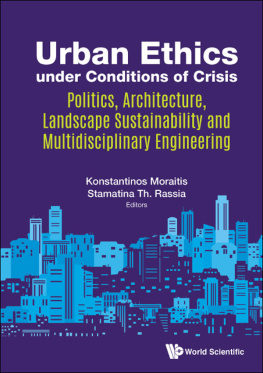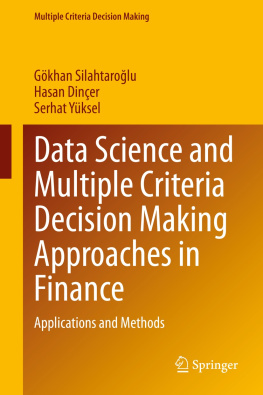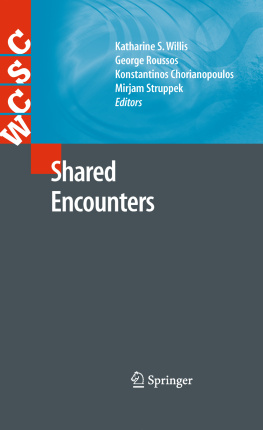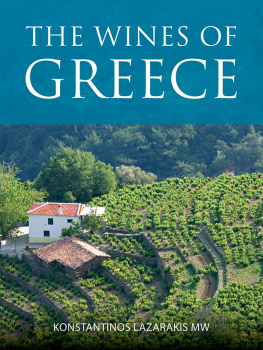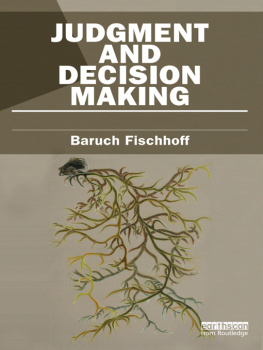Konstantinos V. Katsikopoulos - Classification in the Wild: The Science and Art of Transparent Decision Making
Here you can read online Konstantinos V. Katsikopoulos - Classification in the Wild: The Science and Art of Transparent Decision Making full text of the book (entire story) in english for free. Download pdf and epub, get meaning, cover and reviews about this ebook. year: 2021, publisher: MIT Press, genre: Children. Description of the work, (preface) as well as reviews are available. Best literature library LitArk.com created for fans of good reading and offers a wide selection of genres:
Romance novel
Science fiction
Adventure
Detective
Science
History
Home and family
Prose
Art
Politics
Computer
Non-fiction
Religion
Business
Children
Humor
Choose a favorite category and find really read worthwhile books. Enjoy immersion in the world of imagination, feel the emotions of the characters or learn something new for yourself, make an fascinating discovery.

- Book:Classification in the Wild: The Science and Art of Transparent Decision Making
- Author:
- Publisher:MIT Press
- Genre:
- Year:2021
- Rating:5 / 5
- Favourites:Add to favourites
- Your mark:
- 100
- 1
- 2
- 3
- 4
- 5
Classification in the Wild: The Science and Art of Transparent Decision Making: summary, description and annotation
We offer to read an annotation, description, summary or preface (depends on what the author of the book "Classification in the Wild: The Science and Art of Transparent Decision Making" wrote himself). If you haven't found the necessary information about the book — write in the comments, we will try to find it.
Classification in the Wild: The Science and Art of Transparent Decision Making — read online for free the complete book (whole text) full work
Below is the text of the book, divided by pages. System saving the place of the last page read, allows you to conveniently read the book "Classification in the Wild: The Science and Art of Transparent Decision Making" online for free, without having to search again every time where you left off. Put a bookmark, and you can go to the page where you finished reading at any time.
Font size:
Interval:
Bookmark:
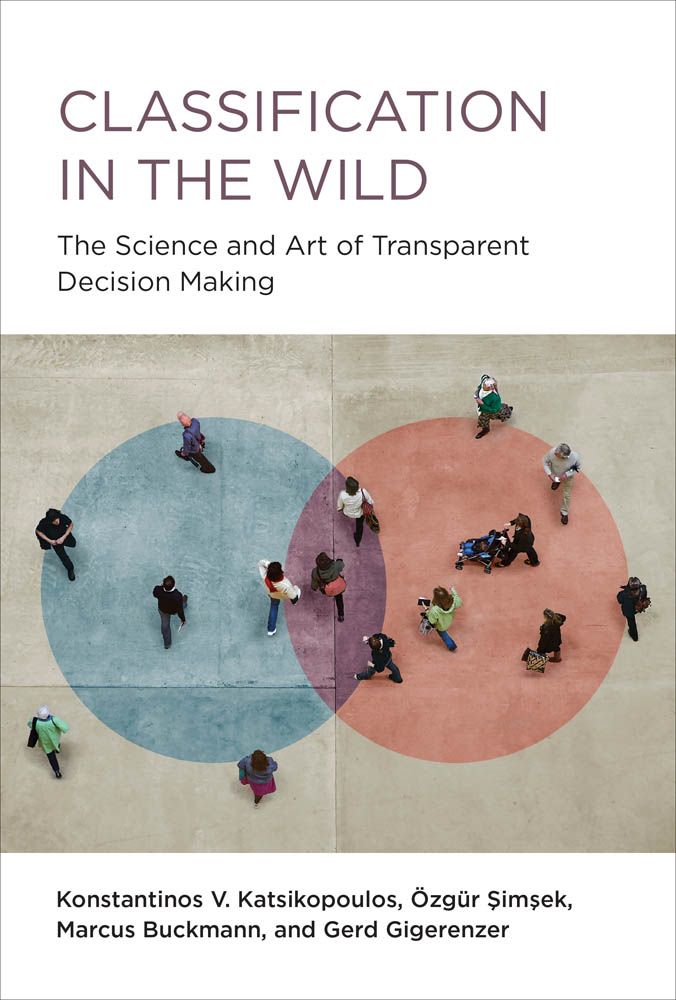
Konstantinos V. Katsikopoulos, zgr imek, Marcus Buckmann, and Gerd Gigerenzer
The MIT Press
Cambridge, Massachusetts
London, England
2020 Massachusetts Institute of Technology
All rights reserved. No part of this book may be reproduced in any form by any electronic or mechanical means (including photocopying, recording, or information storage and retrieval) without permission in writing from the publisher.
Library of Congress Cataloging-in-Publication Data
Names: Katsikopoulos, Konstantinos V., author.
Title: Classification in the wild : the science and art of transparent decision making / Konstantinos V. Katsikopoulos, zgr imek, Marcus Buckmann, and Gerd Gigerenzer.
Description: Cambridge, Massachusetts : The MIT Press, [2020] | Includes bibliographical references and index.
Identifiers: LCCN 2020015193 | ISBN 9780262045155 (hardcover)
Subjects: LCSH: Categorization (Psychology)Case studies. | ClassificationCase studies. | UncertaintyCase studies.
Classification: LCC BF445 .K38 2020 | DDC 001.01/2dc23
LC record available at https://lccn.loc.gov/2020015193
10 9 8 7 6 5 4 3 2 1
d_r0
To our families
This book benefited greatly from the input provided by many colleagues. We are grateful to David Aikman, Jerome Busemeyer, Jean Czerlinski Whitmore, Uwe Czienskowski, Dan Goldstein, Panagiotis Katsikopoulos, Niklas Keller, Jan Malte Lichtenberg, Shenghua Luan, Laura Martignon, Douglas Medin, Nancy Montgomery, Christophe Mues, Nathaniel Phillips, Lael Schooler, Leonidas Spiliopoulos, and Leighton Vaughan Williams. We are indebted to Gisela Henkes for administrative help and Rona Unrau for suggestions on the writing. Finally, we would like to extend a big thanks to Philip Laughlin, Judy Feldmann, and Alex Hoopes, our editorial support at the MIT Press.
The demand for certainty is one which is natural to man, but is nevertheless an intellectual vice. If you take your children for a picnic on a doubtful day, they will demand a dogmatic answer as to whether it will be fine or wet, and be disappointed in you when you cannot be sure.
Bertrand Russell
The desire to assign a person to a classfriend or foe, trustworthy or notis inherent to human nature. It provides the bricks from which intelligence is built. Without forming classes, we would notice only the particular, and any general idea would be out of reach. But how do we make classifications? And how should we?
Psychologists tend to focus on well-defined situations, where all characteristics of the entities to be classified are known with certainty, including probabilities. To achieve the goal of experimental control, the typical lab experiment requires people to allocate to classes artificial objects, such as circles and triangles that vary in color and size, that is, in terms of a precisely known, fixed number of dimensions.
Classification in the Wild, in contrast, exits the certainty of the lab and looks at fundamental uncertainty. In the wild refers to real-world situations where, unlike in the typical psychological experiment, the future is not knowable, and uncertainty cannot be meaningfully reduced to probability. As we will see, these formal models combine well with the expertise of practitioners, thus the science and art in the books subtitle.
Researchers in machine learning also address classification. They have developed tools such as neural networks and random forests for complex situations that go beyond the lab experiment. These tools are able to deal with complexity and uncertainty but are typically not transparent. For instance, when systems based on these tools are used in financing or in courts of law, loan applicants and defendants are typically mystified about why they are classified as untrustworthy and denied a loan or bail. Often such systems fail to be transparent not only to the bank or the judge but also to the engineers who created them.
Classification in the Wild is committed to increasing transparency in situations of uncertainty. It provides tools that are easy to understand, memorize, teach, and execute. These tools allow practitioners to make fast and accurate decisions when no fancy machine learning program is at hand, as at the site of an accident or suicide attack. It also informs machine learning in how to construct transparent algorithms in the first place, rather than trying to explain opaque algorithms after the fact.
Another deep difference exists between cognitive psychology and machine learning. Psychology is mostly descriptive, answering the question of how people actually make classifications. Machine learning is prescriptive, answering the question of how one should make classifications. Classification in the Wild integrates the is and the ought. It deals with heuristics that often are both descriptive and prescriptive; that is, they describe what experienced practitioners actually do, while also suggesting how their practices can be improved.
The classification tools we present in this book are known under the rubric of bounded rationality, a term coined in the 1950s by Herbert Simon, Fast-and-frugal heuristics are useful additions to existing models in cognitive psychology and machine learning, allowing for fast, transparent, and accurate classifications under uncertainty.
Classification in the Wild provides points of contact where cognitive psychology and machine learning can meet. It shows how to extend the psychological study of classification to the real world of uncertainty. It also shows how to derive simple and accurate classification rules from first cognitive principles, the human abilities of counting and ordering. Additionally, the book contributes to the goal of interpretable machine learning. Fast-and-frugal classification rules can be easily understood and applied.
In Classification in the Wild, we make two key arguments:
- Simple rules do well in the wild. In stable situations such as the games of chess and Go or face recognition, complex algorithms outperform fast-and-frugal heuristics if large amounts of data are available. In the wild, by contrast, where the future is uncertain and may differ from the past in unpredictable ways, simple heuristics can outperform complex methods regardless of whether the available data are big or small. We call this the unstable-world principle.
- Transparency is a key value. More and more our lives are influenced by algorithms that classify citizens according to their creditworthiness, health conditions, and social and political attitudes. The underlying logic of these algorithms is often opaque, be it inherently or with the aim to protect trade secrets. Fast-and-frugal heuristics, on the other hand, are transparent by design. In sensitive domains such as health, wealth, and justice, the ability to understand algorithms is indispensable for citizens in a participatory democracy. Contrary to common wisdom in parts of machine learning, which assume that the most accurate algorithms must be inherently complicated and uninterpretable, we show that transparent algorithms are often as accurate as black-box models. We call this the transparency-meets-accuracy principle.
In this book, we show that these two arguments go together. The choice is not between using complex algorithms that are hard to understand and simple ones that are hardly accurate. In the wild, simplicity and transparency are not enemies of accuracy.
Next pageFont size:
Interval:
Bookmark:
Similar books «Classification in the Wild: The Science and Art of Transparent Decision Making»
Look at similar books to Classification in the Wild: The Science and Art of Transparent Decision Making. We have selected literature similar in name and meaning in the hope of providing readers with more options to find new, interesting, not yet read works.
Discussion, reviews of the book Classification in the Wild: The Science and Art of Transparent Decision Making and just readers' own opinions. Leave your comments, write what you think about the work, its meaning or the main characters. Specify what exactly you liked and what you didn't like, and why you think so.



